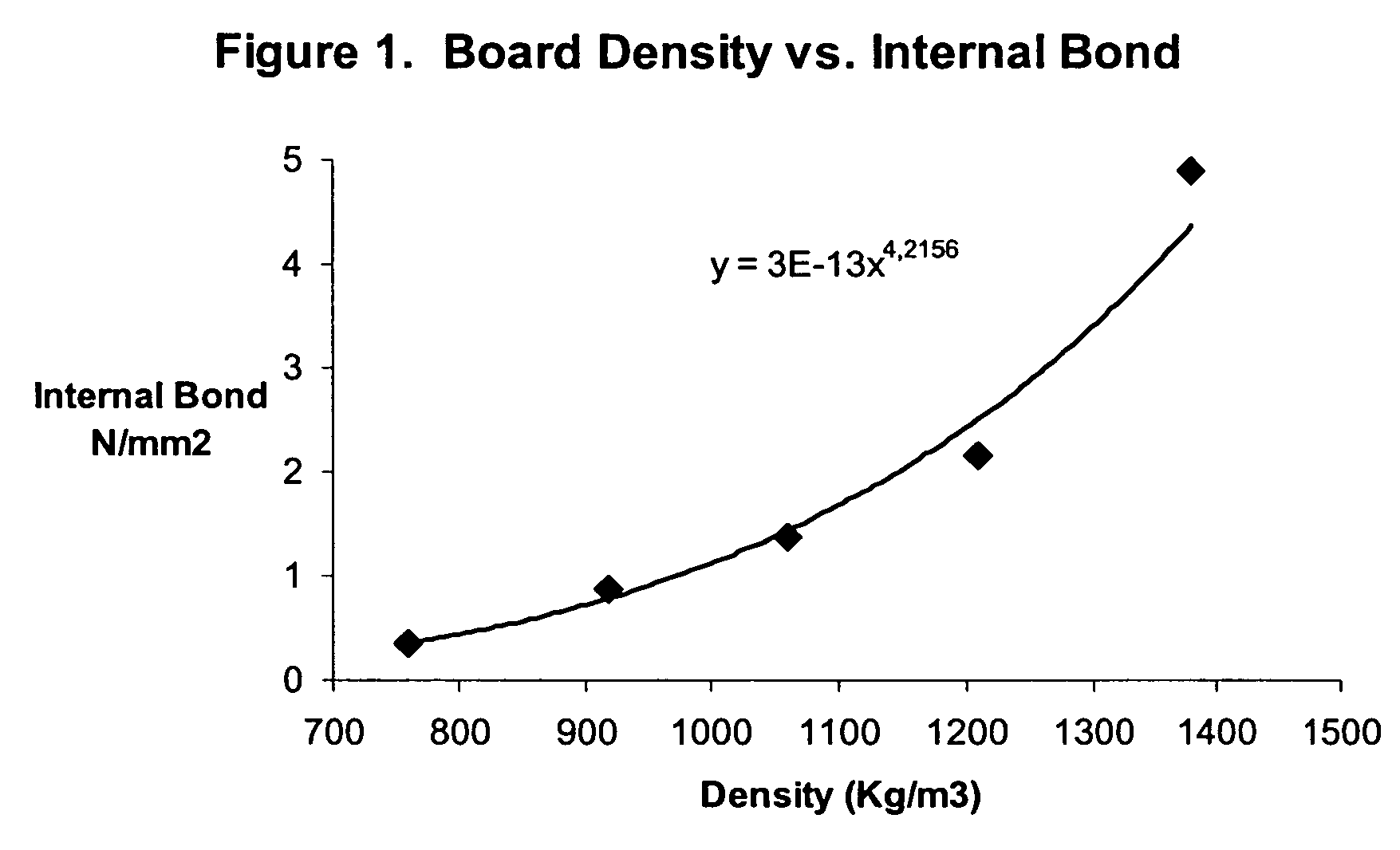Method for making dimensionally stable composite products from lignocelluloses
a technology of lignocellulosic material and composite products, which is applied in the field of making highly dimensionally stable composite products from lignocellulosic material, can solve the problems of affecting the bonding process, affecting the product's water resistance, and consuming a lot of raw materials, so as to improve the water resistance of the product, strengthen the physical properties, and improve the product's density
- Summary
- Abstract
- Description
- Claims
- Application Information
AI Technical Summary
Benefits of technology
Problems solved by technology
Method used
Image
Examples
example 2
[0038]This example demonstrates the use of higher pressing temperature and / or longer pressing time to enhance the dimensional stability, particularly the thickness swelling, of lignocellulose panel boards. Fresh maple chips containing about 57% moisture content was treated with high pressure steam (198 C) for about 8 minutes. The treated maple chips were fed through a disc refiner under steam pressure of 6 bars to process the treated maple chips into fibers. The wet fibers were dried by hot air to a moisture content of 3–5%. The dry fibers were felted into a mat 400×400 mm. A total of 8 mats were made in an identical manner. These 8 mats were hot pressed at a platen temperature ranging from 160–220 degrees Celsius and pressed for a time ranging from 2–4 minutes. Target thickness was 8.0 mm and target density was 1,050 Kg / m3.
[0039]Test results are listed in Table 2. It is evident that mechanical properties were not significantly affected by the higher press temperature and long press...
example 3
[0041]This example illustrates the flexibility of the inventive process for making preformed semi-rigid, partially cured sheets in the thickness range of 6 to 12 mm to a density between 550 to 900 Kg / m3 for future processing into high density composite plates. The preformed sheets of fibreboard can be effectively and economically produced on a continuous press. The semi-rigid sheets are easily handled in a subsequent operation to yield a final composite product, or readily packed for shipping or storage, in contrast to the soft and fragile mats used in conventional processes.
[0042]Mixed beech and pine wood chips at a ratio of 65:35, by volume, were continuously loaded into a digester (chip cooker) at a commercial medium density fiberboard plant. The chips were cooked under a steam pressure of 12 bar (190 C) for about 10 minutes and then extruded continuously through a pressurized refiner with counter-rotating disc plates that comminuted the steam treated wood chips into fibers and f...
example 4
[0043]This example shows the densification of preformed sheets into high density composite panelboards. The preformed rigid MDF sheet, 10 mm thick, 700 kg / m3 density, containing less than 2% moisture content was, in a second operation, compressed into high density fiberboard. Two of the preformed MDF sheets were placed in a single daylight press. They were pressed under a specific pressure of 1,100 psi and a platen temperature of 165 Celsius for 25 minutes. At the end of the heating period the platen temperature was lowered to about 70 Celsius in about 3 minutes. At this time the pressure was reduced to 0 and the press was opened. The average density of this high density 10 mm fiber board was 1,370 Kg / m3. Bending strength (MOR) was 87.5 MPa, MOE: 9,740 MPa, Internal Bond: >3.5 MPa, thickness swelling after 24 hour soaking: 1–2%, and after 2 hour boiling: 4–6%, linear expansion in the length of 0.17% and linear expansion in the width of 0.16%.
PUM
| Property | Measurement | Unit |
|---|---|---|
| thickness | aaaaa | aaaaa |
| density | aaaaa | aaaaa |
| thickness | aaaaa | aaaaa |
Abstract
Description
Claims
Application Information
 Login to View More
Login to View More - R&D
- Intellectual Property
- Life Sciences
- Materials
- Tech Scout
- Unparalleled Data Quality
- Higher Quality Content
- 60% Fewer Hallucinations
Browse by: Latest US Patents, China's latest patents, Technical Efficacy Thesaurus, Application Domain, Technology Topic, Popular Technical Reports.
© 2025 PatSnap. All rights reserved.Legal|Privacy policy|Modern Slavery Act Transparency Statement|Sitemap|About US| Contact US: help@patsnap.com

